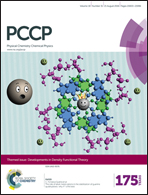Scandium carbides/cyanides in the boron cage: computational prediction of X@B80 (X = Sc2C2, Sc3C2, Sc3CN and Sc3C2CN)†
Abstract
As the first study on metal carbide/cyanide boron clusterfullerenes, the geometries, energies, stabilities and electronic properties of four novel scandium cluster-containing B80 buckyball derivatives, namely Sc2C2@B80, Sc3C2@B80, Sc3CN@B80 and Sc3C2CN@B80, were investigated by means of density functional theory computations. The rather favorable binding energies, which are very close to those of the experimentally abundant carbon fullerene analogues, suggest a considerable possibility to realize these doped boron clusterfullerenes. Their intracluster and cluster–cage bonding natures were thoroughly revealed by various theoretical approaches. In contrast to carbon clusterfullerenes, in which the encaged non-metal atoms mainly play a stabilizing role in the metal clusters, the encapsulated carbon and nitrogen atoms inside the B80 cage covalently bond to the boron framework, resulting in strong cluster–cage interactions. Furthermore, infrared spectra and 11B nuclear magnetic resonance spectra were simulated and fingerprint peaks were proposed to assist future experimental characterization.


 Please wait while we load your content...
Please wait while we load your content...